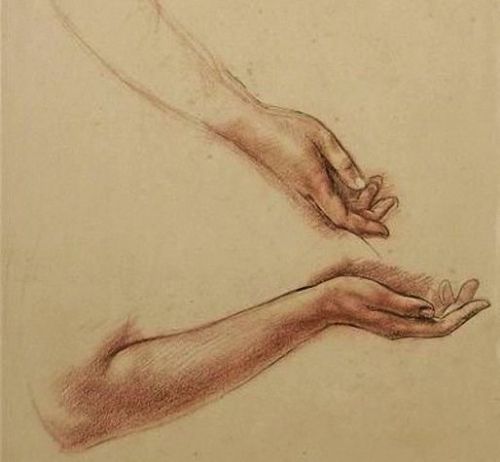
Hand and forearm: two studies, for Allegory, circa 1925
Passe-partout (ref: 1047)
Red chalk over outline in black ink, 19 x 13 in. (48.2 x 33 cm.)


The cartoon and related studies, commenced in the
Spring of 1924, occupied the larger part of the second year of Monnington's Scholarship. He commenced the execution of the painting, which was to
occupy his third and final year, in March 1925; it was purchased in
Rome, by Jim Ede for the Contemporary Art Society, before it was
completed and was presented to the Tate Gallery in 1939. The exact
meaning of the Allegory is unclear and Monnington himself remained
elusive about it; invited by the Tate to explain it, he replied, The
idea is a bit complex and was based on the story of the Garden of Eden,
but rather a personal interpretation of it” (letter of 17 May 1953).
When pressed, a few years later to elaborate, he answered, “I don’t
think this picture has anything to do with the Garden of Eden story,
but I am no more able to explain its exact meaning now than I was at
the time I painted it. The whole design certainly had a very particular
meaning and purpose and was an attempt to express in pictorial form my
attitude to life - almost my faith (2nd April 1957). Having to be
content with this, the Tate Gallery retitled the picture Allegory -
Monnington having always referred to it simply by the title Decoration.
Iconogrpahically it contains elements of several myths but most
obviously The Garden of Love; specific episodes within the painting are
reminiscent of Adam and Eve; Apollo and Daphne; The Fountain of Youth.
Luciano Chelles has pointed out that the composition is to some extent
an adaptation of Piero della Francesca’s Death of Adam (San Francesco,
Arezzo) and reproduces specific elements such as the figure sitting on
the ground and the placing of a large tree at the centre of the
composition. Ricketts and Shannon, asked by the Faculty of Painting at
the British School to report on Monnington’s progress commented that
they found Monnington, “keenly alive to the merit of the Masterpieces
he had seen in Italy and alive to the technical practises of the
Masters” (12.1.25)
“The cartoons and studies Monnington has made ... are characterized by
the utmost thoroughness and care; and some of his pencil drawings of
hands, feet, plant forms etc.’ being quite notable in their sense of
finsih and beauty” (Charles Ricketts, letter to Evelyn Shaw 12.1.25)